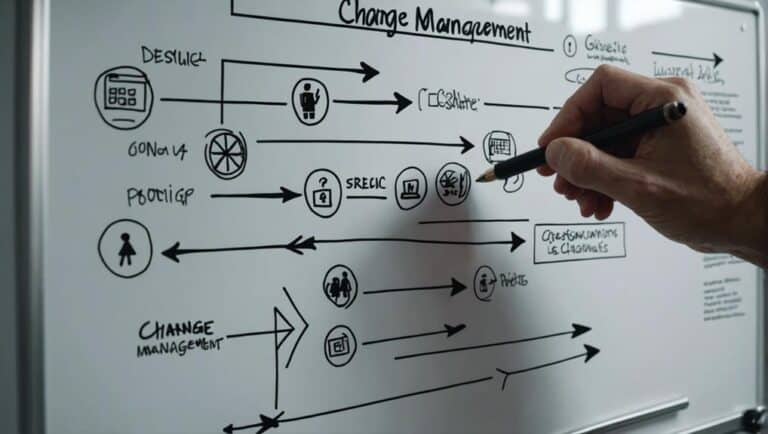Are you considering implementing a change management strategy in your business? It’s important to be informed about the process and know what to expect. Unfortunately, there are a lot of myths and misconceptions out there that can create confusion and cause problems if left unchecked.
In this blog post, we will look at eight of the most common change management misconceptions so that you can get started on the right foot.
Common Misconceptions about Change Management
Change management can be a daunting process, but it doesn’t have to be. By understanding the common misconceptions about change management, you can ensure that your business is well-prepared for any changes that come its way.
Let’s explore eight of the most common misconceptions about change management, so you can make sure your business is ready for success.
Misconception #1: Change Happens Quickly Once Announced
Thinking that change happens quickly once it’s been announced is a common mistake that many organizations make.
It is true that after announcing a change, the organization should be prepared to implement it quickly. However, it is important to remember that change takes time and there will likely be unexpected delays due to various factors.
It is also important to remember that not all employees will adjust quickly to changes and may require additional support and guidance.
As such, organizations should plan for the process of change and be prepared to continuously monitor progress in order to ensure successful implementation.
Misconception #2: Success Relies on Communicating Your Message Effectively
It’s true that communicating your message effectively is essential for successful change management. But it’s not the only component that you should be focusing on.
Change management also involves sponsorship, coaching, and proactive planning. If you ignore any of these components, then you’re likely to find yourself with a failed change initiative.
That’s why it’s important to remember that while effective communication is necessary, it’s not the only factor in successful change management.
Make sure you have all your bases covered to ensure that your change effort is successful.
Misconception #3: “My People Will Follow Orders When I Tell Them To Change”
Managers often mistakenly assume that employees will follow orders and immediately accept any change that is announced.
The reality is that managing change requires an understanding of the psychological barriers that can prevent people from embracing change.
Leaders need to recognize and address resistance to change, as well as understand the importance of involving employees in the change process.
Change is a complex endeavor, and leaders need to take an active role in helping employees understand and embrace it.
With a comprehensive plan for successful change management, leaders can create an environment where everyone feels empowered to work together towards a common goal.
You should also check out The Fear of Change: Why Is It So Hard For People And Companies To Accept Change?
Misconception #4: Resistance to Change is Always Negative
It is a common misconception that resistance to change is always negative. In fact, while resistance can be an obstacle to successful change management, it can also be a sign of strength and an opportunity for growth.
Leading thinkers have identified five key roles for managers and supervisors in times of change: communicator, advocate, coach, liaison and resistance.
These roles provide opportunities to engage employees in the change process and to understand their perspectives on the changes taking place.
By taking the time to understand why people are resistant, companies can work with employees to create meaningful change and overcome resistance.
Misconception #5 Change Management is all about Technology
Many people assume that a change process only involves new technology or software, when in reality it is a much more complex and complete process.
While technology plays a major role in most changes, the process itself includes risk mitigation strategies, training, user engagement and adoption, data analysis and interpretation, and more.
All of these components play an important role in ensuring the success of any planned change effort.
Misconception #6 Change Management Can Fix Problems on its Own
Contrary to popular belief, simply implementing a change management plan will not magically fix any of your company’s problems.
It is important to remember that changes in the organization need commitment from all levels of the organization, from the front line to the leadership, to ensure a successful integration.
Misconception #7 There is a “One-Size-Fits-All” Approach
When it comes to managing organizational changes, often there isn’t a “one-size-fits-all” approach as every organization has its own unique structure and culture which will dictate how certain changes can be implemented or managed best for that specific environment.
As such, it’s important to recognize this fact before beginning any major organizational changes or implementation. While frameworks exist as general guidelines, they should not be seen as the only way to deal with problems within a given organization.
Misconception #8 Organizational Culture Can’t Be Changed
One common misconception about change management is that organizational culture can’t be changed through processes or strategic interventions; however, this is not true at all.
By identifying objectives, engaging stakeholders at all levels (front line workers & executives), plus providing tools & resources necessary for achieving desired behaviors & practices – organizations can make deep & lasting modifications throughout the work&culture climate over time with concerted effort!

The Role of Leadership in Change Management
Leadership plays a crucial role in successful change management. Leaders are responsible for setting the tone and building trust with their teams. During the transition, this creates an environment where people feel supported and comfortable.
Leaders must also be able to develop a vision for the change and communicate it effectively to inspire and motivate employees.
Additionally, they need to be able to anticipate potential obstacles and develop strategies for overcoming them.
Finally, leaders must be active participants in the change process and support their teams through every stage of it. By taking these steps, leaders can ensure that their organization’s transition is successful, efficient, and effective.
Planning for Successful Change Management
Planning for successful change management is essential for any organization looking to make lasting and impactful changes.
When planning for change, it is important to consider the needs of all stakeholders and ensure that the change process is well-structured and efficient.
This includes providing adequate training and resources to employees, creating an environment where employee feedback is welcomed, and developing a comprehensive transition strategy.
Additionally, leaders should be involved in the process from start to finish, as their guidance and support can be invaluable when it comes to mitigating resistance to change.
By taking the time to properly plan for change, organizations can ensure that their transition is as successful as possible.
Involving Employees in the Change Process
Involving employees in the change process is an essential part of successful change management.
It is important to understand that employees need to be given the opportunity to have a say in how the process is carried out.
Asking for employee feedback and input can help ensure that the changes are seen as beneficial and will be accepted by all stakeholders.
It also helps to ensure that any potential issues or problems can be identified early on, and addressed before they become roadblocks.
Additionally, involving employees in the change process can help to create a sense of shared ownership and responsibility for the success of the project.
This sense of ownership can be incredibly powerful in motivating employees to work together towards successful implementation.
Strategies for Overcoming Resistance to Change
The most important thing to overcome resistance to change is to make sure that everyone knows why the change is needed, and how it will benefit them and the organization.
Involving employees in the change process can help facilitate a smoother transition. It gives employees a chance to give their feedback and help to make changes.
Education and communication are also key components of successful change management. They allow people to know how the changes will affect them and how they will work.
Leadership also plays an important role in successful change management, as they can provide knowledge, guidance and direction to those involved in the process.
By taking the time to implement effective change management strategies and plan for successful change management, you can ensure that your organization will move forward with minimal disruption.
What are some common misconceptions about change management that people should be aware of when using change management techniques?
Some common misconceptions about change management techniques usage include the belief that it’s a one-size-fits-all solution, that it only involves upper management, and that it’s a quick fix. In reality, successful change management requires tailored strategies, involvement at all levels, and a long-term commitment to sustained improvement.
Conclusion
In conclusion, it is important to recognize that change management is a complex process and requires strategic planning and leadership.
To ensure successful change management in any organization, it is important that organizations have effective communication strategies. It is also important to include employees in the change process.
It is also important to ensure that all staff have access to the necessary resources and training they need to effectively implement the changes.
By taking these steps and recognizing the common misconceptions about change management, organizations can successfully implement change in their organization.





